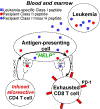Proceedings From the Fourth Haploidentical Stem Cell Transplantation Symposium (HAPLO2016), San Diego, California, December 1, 2016
- PMID: 29339270
- PMCID: PMC7187910
- DOI: 10.1016/j.bbmt.2018.01.008
Proceedings From the Fourth Haploidentical Stem Cell Transplantation Symposium (HAPLO2016), San Diego, California, December 1, 2016
Abstract
The resurgence of haploidentical stem cell transplantation (HaploSCT) over the last decade is one of the most important advances in the field of hematopoietic stem cell transplantation (HSCT). The modified platforms of T cell depletion either ex vivo (CD34+ cell selection, "megadoses" of purified CD34+ cells, or selective depletion of T cells) or newer platforms of in vivo depletion of T cells, with either post-transplantation high-dose cyclophosphamide or intensified immune suppression, have contributed to better outcomes, with survival similar to that in HLA-matched donor transplantation. Further efforts are underway to control viral reactivation using modified T cells, improve immunologic reconstitution, and decrease the relapse rate post-transplantation using donor-derived cellular therapy products, such as genetically modified donor lymphocytes and natural killer cells. Improvements in treatment-related mortality have allowed the extension of haploidentical donor transplants to patients with hemoglobinopathies, such as thalassemia and sickle cell disease, and the possible development of platforms for immunotherapy in solid tumors. Moreover, combining HSCT from a related donor with solid organ transplantation could allow early tapering of immunosuppression in recipients of solid organ transplants and hopefully prevent organ rejection in this setting. This symposium summarizes some of the most important recent advances in HaploSCT and provides a glimpse in the future of fast growing field.
Keywords: Cellular therapy; Haploidentical transplantation; Immunologic reconstitution; Post-transplantation cyclophosphamide; T cell depletion.
Copyright © 2018 The American Society for Blood and Marrow Transplantation. Published by Elsevier Inc. All rights reserved.
Figures
References
-
- Gratwohl A, Pasquini MC, Aljurf M, et al. One million haemopoietic stem-cell transplants: a retrospective observational study. The Lancet Haematology 2015;2:e91–100. - PubMed
-
- Devine SM. Haploidentical Hematopoietic Cell Transplantation Using Post-Transplantation Cyclophosphamide: Does Graft Source Matter? Journal of clinical oncology : official journal of the American Society of Clinical Oncology 2017;35:2984–6. - PubMed
-
- Santos GW, Owens AH. Production of graft-versus-host disease in the rat and its treatment with cytotoxic agents. Nature 1966;210:139–40. - PubMed
Publication types
MeSH terms
Grants and funding
LinkOut - more resources
Full Text Sources
Other Literature Sources
Research Materials


